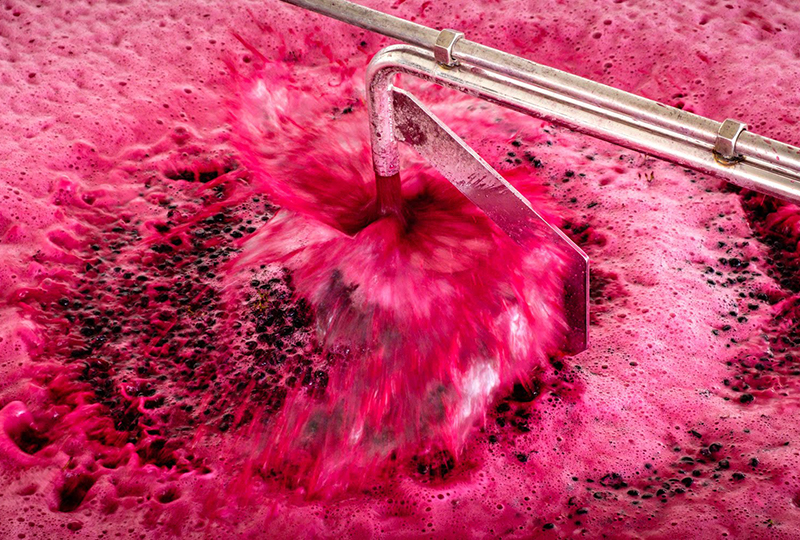Vintage 2021 - what a year!

I’ve said it before, and I’ll say it again, growing grapes has as much to do with mother nature as it does with the vigneron. We are at the mercy of what she chooses to serve up and something as simple as too much wind or rain on the wrong day can drastically affect how the crop will turn out.
Each year we hope for a “perfect” season, one featuring rain at the right times, a slow increase in temperatures, no prolonged heat waves, no hail, long sunny days and consistent overnight temperatures for even fruit ripening. More often than not, one of these things goes wrong and we do what we can to mitigate the damage or help the vines along with pruning or thinning, disease management, and watering techniques, but nothing can truly replace a good season.
2021 was one of the best seasons I have seen for our Hard Hill Road vineyard, as it was for most of the Grampians region. At the beginning of the season things looked bright, and when the fruit started to set it looked as though it was going to be a big crop. But so often in the agricultural industry, what happens at the start of the season does not always translate to the harvest. But this year it delivered – great fruit-set followed by a perfect ripening season gave us the biggest crop ever. All in stark contrast to last year, as this year we picked three times as much as we did last year!
In addition to it being a huge vintage, it was the most orderly and serene harvest I’ve seen in a very long time. All the grapes were extremely polite and ripened in their correct order. The end of the season stayed cool, with none of the usual extreme heatwaves, which saw the whites ripen one at a time before the reds started and they too spread themselves out in an orderly fashion.
This was particularly important this year, as it wasn’t just our vineyard that saw bumper crops. Everyone in the region did, and as I make wine for quite a few of my neighbouring vineyards, this slower, spread-out ripening of fruit was a critical factor in the constant juggling act that vintage is in the winery. Grape deliveries, crushing, fermenting, plunging caps, pumping over, pressing, malo ferments, racking into barrels, shovelling out must, and cleaning, cleaning, and more cleaning in between each movement of each grape/wine parcel. It’s a hive of activity.
In a normal year, this is more than enough to keep you busy over the many long days and nights of vintage, but because I’m a sucker for punishment, I decided to install a bottling line into our small winery earlier this year. So, while we were pressing reds, we were bottling whites, which is not only unusual but adds a whole other layer of complexity to the logistics and planning.
The weather has cooled off quickly in the lead up to winter this year, and lots of rain has thankfully come with it. This rain will now regenerate the deepest layers of the soil and start to repair some of the deficits the last few hot and dry seasons have caused and will set our vines up for another good crop next year.
In addition to its positive effect in the vineyard, the cooler weather has caused the malo ferments on the reds to slow down. This slowing creates a more complex and layered wine, so it's nice when it happens, despite the extra waiting. All the wines are looking great this year – the whites are very elegant with a beautifully crisp acid structure, especially in the Rieslings, and the reds are full of pepper and spice and deep berry flavours.
Operating as a contract winemaker in a small region like Great Western and the Grampians gives me unique access to see all the exciting varieties now growing in the region, and participate in the changing face of wine styles that have become synonymous throughout our region. So, if you think you know what the Grampians are all about, think again, and come and try what’s new for yourself.
Our 2021 white wines have now all just been released – our Pinot Gris was bottled as soon as we could get it ready, in early June. The Riesling was bottled the first week of July and the Rosé just last week. The 2021 reds will be a while away yet as they all need to be tucked into their barrels and mature, but I have already started planning for a relatively early release of the 2021 Chockstone Shiraz, as we will likely run out of stock by the end of December.
Well, it's back to the winery for me, still lots to do!
Cheers,
Adam
2019 Vintage Report

Winemakers live for the vintage season. It’s an exciting, stressful, fun and exhausting experience, but it is the one chance a year when we can focus on nothing else but creating our wines. Mother Nature always adds some twists and turns to every vintage, and this season was no exception. What was looking like a nice relaxed on-schedule harvest was thrown to the wind with a two-week heat spell in late Feb/early March just after we picked our Pinot Gris.
Although we normally wouldn’t pick fruit during a heat spells if we can avoid it (I prefer to pick cool grapes), the Chockstone Riesling happened to hit perfect ripeness in the midst of the heatwave, and rather than wait for cooler weather I decided to pick it immediately. So, as you can imagine, it was a great relief to see it come off in perfect condition and with a great balance of acid and flavour. I think the slightly-stressed vines were as happy as me to have the fruit safely picked and in tank.
The white ferments, the Gris and the Riesling, finished in the last week of March and are currently going through the slow process of settling. They look great, wonderfully crisp with a subtle yet aromatic palate. Tasting cool wines from tank is one sure-fire way to forget that hot spell!
Reds always come later as they require more sunshine hours for the flavours to fully develop and for the Baume (sugar), acid and tannin levels to reach my preferred balance, and this doesn’t always happen in the whole vineyard all at once.
I split the Chockstone Shiraz harvest into two parts, the earlier pick from the top more exposed part of the block was harvested just after the Riesling, about two weeks early and came in ripe, rich and showing lots of blackberry and pepper characters. The second half of the block was picked 10 days later and shows a remarkable liquorice and dark chocolate character. Two distinct halves of what looks like one of our best Chockstone Shiraz blends.
We pressed off the last of the Chockstone Shiraz ferments at the end of March, before they commenced their malolactic fermentations (the process where malic acid is converted to the softer lactic acid, which lends a roundness to the wine), and then eventual transfer to barrels for maturation.
The grapes off the Hard Hill Road Close-Planted Shiraz vines were the next to come off, all hand-picked over two days last weekend. The last varieties to be picked, as always, are the Nebbiolo and Tannat, and they will likely be picked this weekend or early next week. Once harvested, they will make up the last of the fruit in our unique blends, The Field and Mule Variation.
The Field is a new blend made up of each of the varieties on our Hard Hill Road vineyard and their percentage of vineyard acreage is their percentage of fruit in the blend: Shiraz 52%, Riesling 22%, Nebbiolo 10%, Durif 9%, Tannat 5% and Viognier 2%. These grapes are fermented in an open-top fermenter with the various grapes being added as they are picked, creating a vintage-long fermentation and a fascinating wine.
The Mule on the other hand is a blend of our most enigmatic red varieties: Nebbiolo, Tannat, Durif, and Shiraz. I carefully handle these big-tannin varieties to keep them soft, supple and under control. I’m aiming for a wine that has a seamless flow between its complex structure and refined fruit flavours.
Overall our yields, while always low (not usually more than five tonnes per hectare), were about on par for the whites and a bit below average for the reds.
Vintages don’t happen without the help of friends and neighbours, so a big thank you to those that have helped out this year, in particular Ian, Andrew, Haydn, and Adrian (visiting from Bali). Cheers boys.
While there have been plenty of afternoon beers on the “three-beer bench” (it took me three beers to make) throughout vintage, it is nearly time to put my feet up for a brief moment, and toast to a successful vintage, before its time to get on the road selling and start pruning all too soon!
Cheers Adam